Share this
MIL-STD-810 Temperature Testing Overview [Methods 501.7, 502.7, 503.7]
by Brett Daniel on May 13, 2020 4:41:55 PM
-4.png?width=1000&name=Untitled%20design%20(10)-4.png)
Graphic: Is your server expected to survive and function in extremely hot or cold environments? Testing to methods 501.7, 502.7 or 503.7 of MIL-STD-810 could save you a lot of follow-up costs.
Note: Trenton Systems is not a compliance testing facility. We manufacture rugged servers and workstations that conform to military and industrial standards, such as MIL-STD-810 and DO-160, and we can ensure that our systems comply with these standards using our in-house testing equipment, or by sending our systems to a third-party compliance testing laboratory for validation, but our facility does not offer compliance testing services for products manufactured outside of Trenton Systems. For a list of laboratories that can assist you with your testing needs, please read this blog post, which lists the best compliance testing laboratories in the world.
This is Part 1 in a series of the different test methods in MIL-STD-810H, the successor to MIL-STD-810G. View Part 2: Vibration Testing.
Legitimate, worthwhile rugged computers undergo all sorts of stress tests to ensure durability and reliability in the field.
But what happens when a rugged computer is exposed to extremely hot, cold or rapidly fluctuating temperatures?
Can its rugged components - the chassis, the processor board or the PCIe backplane - continue to function?
Well, if the computer and its components have been tested within a wide temperature range for MIL-STD-810 certification, they not only can continue to function - they can endure a life cycle that makes total cost of ownership look like pocket change.
MIL-STD-810H includes three methods that test for temperature-related stress:
- Test Method 501.7 – High Temperature
- Test Method 502.7 – Low Temperature
- Test Method 503.7 – Temperature Shock
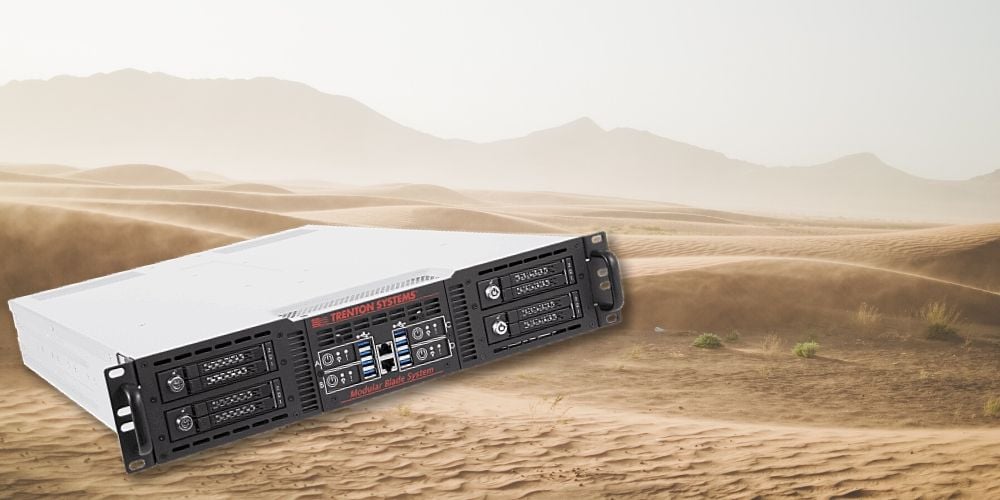
Graphic: Testing the functionality of a rugged computer within a high Mil-Spec temperature range ensures that it can operate in some of the steamiest places on the planet, no matter the program or application. Pictured is a Trenton Systems 2U rugged MIL-STD-810 modular blade server.
Test Method 501.7 - High Temperature
According to MIL-STD-810H, the purpose of Test Method 501.7 - High Temperature is to evaluate the effects of high temperature conditions on material safety, integrity and performance.
In other words, the method assesses the effects of crazy hot temperatures on the condition and performance of a rugged computer in various simulated environments. This is done using special temperature testing equipment.
There are three temperature testing procedures associated with MIL-STD-810H-501.7 – High Temperature. They are:
- Procedure I – Storage - assesses the effects of high temperatures while a device is not in use
- Procedure II – Operation - assesses the effects of high temperatures while a device is in use
- Procedure III – Tactical-Standby to Operational - assesses the ability of material that has soaked in a high-temperature environment to become operational in a short period
Extremely high temperatures can disable, impair or shorten the life cycle of rugged computers that haven not been temperature-tested to survive the conditions of their eventual deployment.
MIL-STD-810H provides the following examples of problems that could result from a systems' exposure to extremely high temperatures:
- Parts bind from differential expansion of dissimilar materials
- Lubricants become less viscous; joints lose lubrication by outward flow of lubricants
- Materials change in dimension, either totally or selectively
- Packing, gaskets, seals, bearings and shafts become distorted, bind and fail causing mechanical or integrity failures
- Gaskets display permanent set
- Closure and sealing strips deteriorate
- Fixed-resistance resistors change in values
- Electronic circuit stability varies with differences in temperature gradients and differential expansion of dissimilar materials
- Transformers and electromechanical components overheat
- Operating/release margins of relays and magnetic or thermally activated devices alter
- Shortened operating lifetime
- Solid pellets or grains separate
- High pressures created within sealed cases (projectiles, bombs, etc.)
- Accelerated burning of explosives or propellants
- Expansion of cast explosives within their cases
- Explosives melt and exude
- Discoloration, cracking, or crazing of organic materials
- Out-gassing of composite materials or coatings (i.e. VOCs, CO and Phthalates)
- Failure of adhesives
Test Method 501.7 tests for high temperature effects in both ambient air and induced temperature environments.
Ambient air environments include environmental conditions, either outdoor or confined, that characterize the air or other medium that surrounds the material. Induced environments include storage, transit and other man-made conditions.
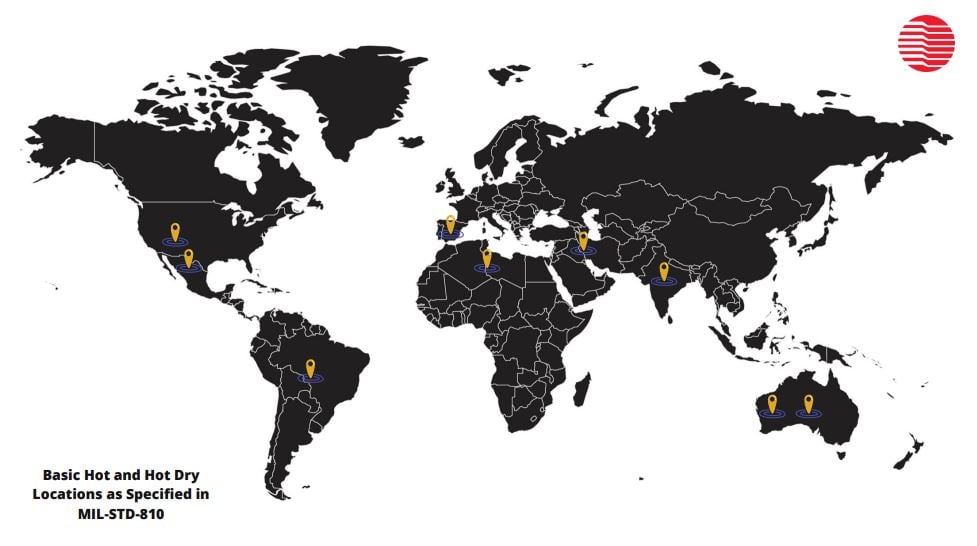
Graphic: Basic hot and hot dry locations as specified in MIL-STD-810
In addition, the method identifies basic hot and hot dry as the two climatic categories where high temperatures are encountered. Locations include:
- Southwestern United States
- Northwestern Mexico
- Central and western Australia
- Saharan Africa
- South America
- Southern Spain
- Southwest and south central Asia
The basic hot daytime temperature cycle ranges for ambient air and induced conditions, respectively, are 30-43°C or 86-110°F and 30-63°C or 86-145°F.
The dry hot daytime cycle ranges for ambient air and induced conditions, respectively, are 32-49°C or 90-120°F and 33-71°C or 91-160°F.
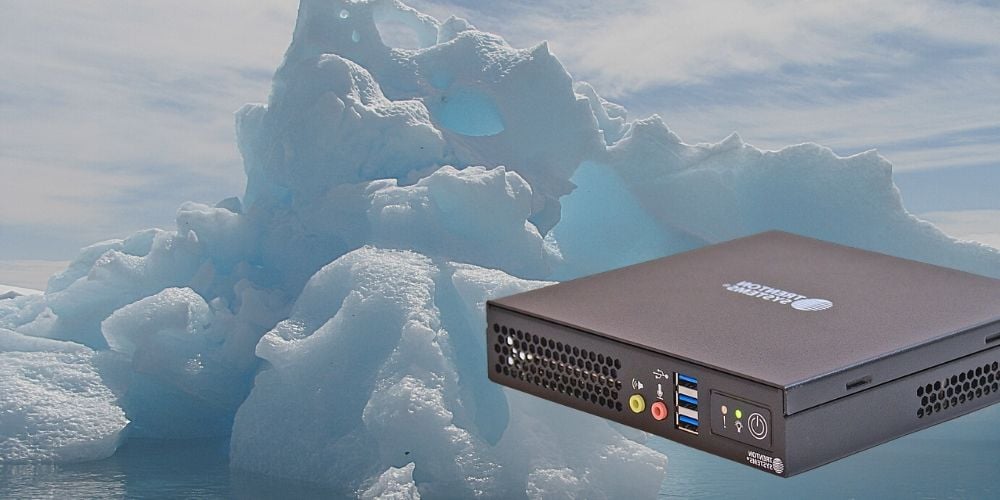
Graphic: Passing the MIL-STD-810 low temperature test helps protect a rugged computer against embrittlement, cracking, stiffening and overall performance decline resulting from icy temperatures. Pictured is the Trenton Systems MIL-STD-810-certified rugged ION Mini PC.
Test Method 502.7 - Low Temperature
According to MIL-STD-810H, the purpose of Test Method 502.7 – Low Temperature is to evaluate the effects of low temperature conditions on material safety, integrity and performance during storage, operation and manipulation.
In simple terms, the method assesses the effects of cold temperatures on the condition and performance of materials in various simulated environments.
There are three testing procedures associated with MIL-STD-810H-502.7. They are:
- Procedure I – Storage - assesses how low temperatures affect a device while it is not in use
- Procedure II – Operation - assesses how low temperatures affect a device while it is in use
- Procedure III – Manipulation - assesses the ease with which materials can be assembled, operated and disassembled by personnel wearing heavy, cold-weather clothing
Exposure to extremely low temperatures can have severe adverse effects on rugged computers not tested to an application-specific environment and certified to MIL-STD-810.
Such exposure may impair the computer's performance or render it totally inoperable. A shorter end-of-life and costly physical damage to the computer’s hardware and components are pretty much a guarantee.
The MIL-STD-810H provides the following examples of problems that could result from a system's exposure to extremely low temperatures:
- Hardening and embrittlement of materials
- Binding of parts from differential contraction of dissimilar materials and the different rates of expansion of different parts in response to temperature transients
- Loss of lubrication and lubricant flow due to increased viscosity. In addition, fuels may gel at low temperature
- Changes in electronic components (resistors, capacitors, etc.)
- Changes in performance of transformers and electromechanical components
- Stiffening of shock mounts
- Cracking of explosive solid pellets or grains, such as ammonium nitrate
- Cracking and crazing, change in impact strength and reduced strength
- Static fatigue of restrained glass
- Effects due to condensation and freezing of water in or on the materiel
- Decrease in dexterity, hearing, and vision of personnel wearing protective clothing
- Change of burning rates
Test Method 502.7 identifies basic cold, cold and severe cold as the three climatic categories where low temperatures are encountered.
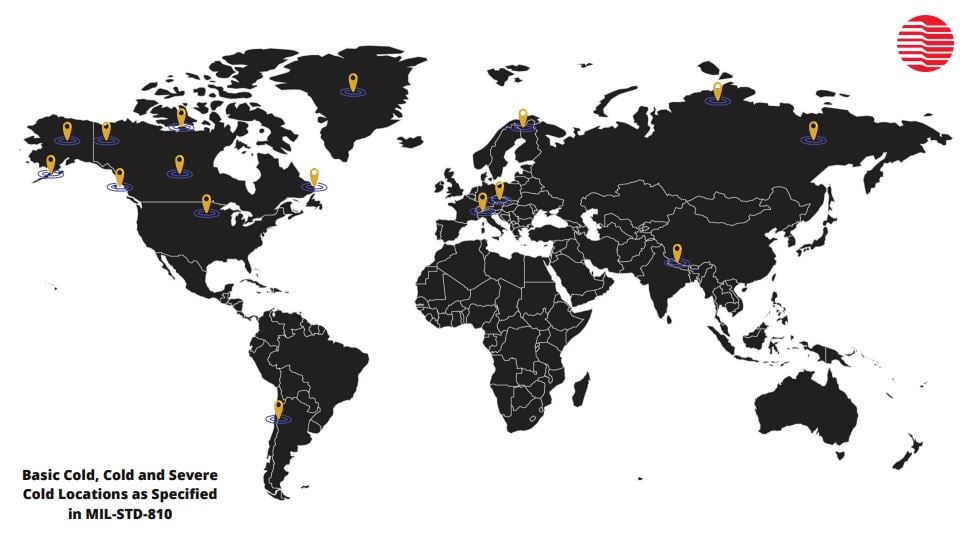
Graphic: Basic cold, cold and severe cold locations as specified in MIL-STD-810
The basic cold category has temperature cycle ranges of -21°C to -32°C or -5°F to -25°F in ambient air conditions and -25°C to -33°C or -13°F to -28°F in induced temperature conditions. Locations include:
- Most of Europe
- The northern contiguous United States
- Coastal Canada
- High-latitude coasts, such as the southern coast of Alaska
- High elevations in lower latitudes
The cold category has temperature cycle ranges of -37°C to -46°C or -35°F to -50°F in both ambient air and induced temperature conditions. Locations include:
- Canada
- Alaska (excluding the exterior)
- Greenland (excluding the “cold pole”)
- Northern Scandinavia
- Northern Asia (certain areas)
- High elevations (Northern and Southern hemispheres)
- The Alps
- The Himalayas
- The Andes
The severe cold has a temperature cycle range of -51°C or -60°F. Locations include:
- Interior of Alaska
- Yukon (Canada)
- Interior of Northern Canadian Islands
- Greenland ice cap
- Northern Asia
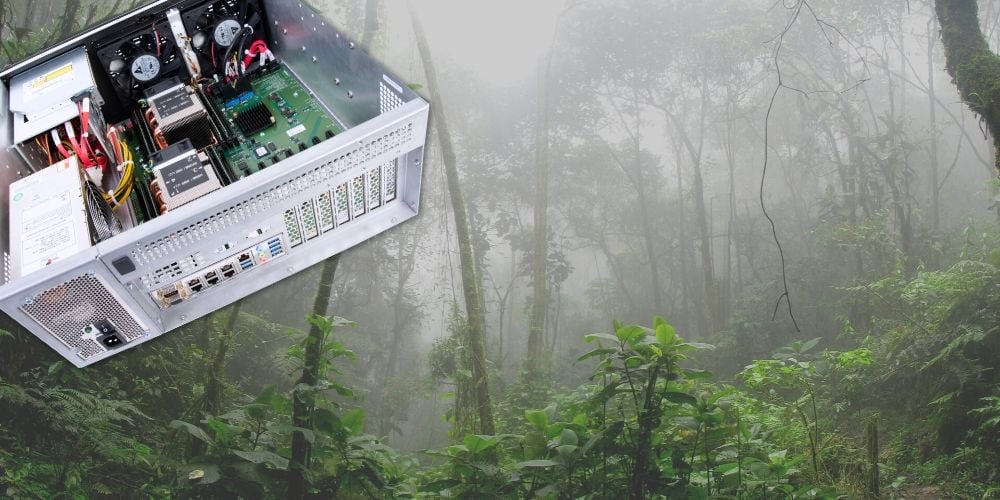
Graphic: Combining the intentions of the MIL-STD-810 high and low temperature tests, the temperature shock assessment analyzes a system's durability and performance after it undergoes sudden temperature spikes or drops. Pictured is a Trenton Systems 4U rugged MIL-STD-810 server.
Test Method 503.7 - Temperature Shock
According to MIL-STD-810H, the purpose of Test Method 503.7 – Temperature Shock is to determine whether materials can withstand sudden changes in temperature without experiencing physical damage or performance decline.
Sudden changes are defined as air temperature changes greater than 10°C or 18°F in one minute.
In simple terms, the method assesses how materials respond to temperature drops and spikes within a one-minute window.
There is only one testing procedure, Procedure I, associated with MIL-STD-810H-503.7. This procedure, however, has four variations based on test length and the shock itself:
- Procedure I-A - one-way shock from constant extreme temperature – at least one shock for each appropriate condition, such as low-to-high temperature, or vice-versa
- Procedure I-B - single cycle shock from constant extreme temperature – one shock for each appropriate condition, such as low-to-high temperature, and one shock in the opposite direction
- Procedure I-C - multi-cycle shocks from constant extreme temperature - a minimum of three shocks at each condition, such as three transfers from cold to hot and three transfers from hot to cold
- Procedure I-D - shocks to or from controlled ambient temperature – follows the same durations of the previous procedures but all shocks are to or from controlled ambient conditions
Temperature shock can disable and hinder the performance of rugged computers and servers involved in mission-critical applications if they’re not stress-tested for application-specific environmental conditions and certified to MIL-STD-810.
The MIL-STD-810H provides the following examples of problems that could result from temperature shock:
- Physical: shattering of glass vials and optical material, binding or slackening of moving parts, cracking of solid pellets or grains in explosives, differential contraction or expansion rates of induced strain rates of dissimilar materials, deformation or fracture of components, cracking of surface coatings, leaking of sealed compartments, failure of insulation protection
- Chemical: separation of constituents, failure of chemical agent protection
- Electrical: changes in electrical and electronic components, electronic or mechanical failures due to rapid water or frost formation
Real-world conditions in which temperature shock is likely to occur include:
- Aircraft flight exposure – during which materials are likely to be exposed to ground heat and direct solar heating directly before being exposed to the low temperatures associated with increasing altitude
- Desert air delivery – during which materials in an unheated, high-altitude aircraft are being transported to a high-temperature environment at ground level, such as during an air drop
- Ground transfer – during which materials are being transported from a conditioned building or enclosure to an environment with extremely high or low temperatures
The effects of temperature shock do not discriminate, and the ramifications can be mechanically dire. That's why it's important to purchase rugged servers and workstations from a manufacturer that actually certifies them to MIL-STD-810 using the right temperature testing equipment.
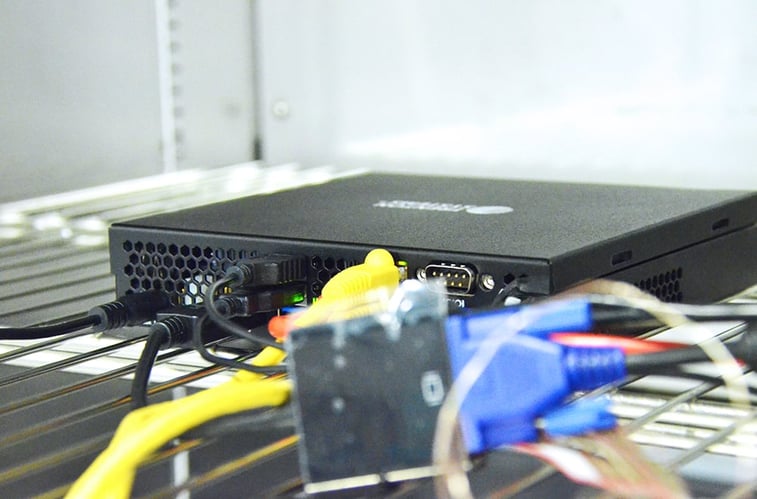
Photo: The ION Mini PC in the Thermotron test chamber just before undergoing a series of in-house stress tests at Trenton Systems.
Temperature Testing at Trenton Systems
Using its in-house temperature testing chamber, Trenton Systems puts its rugged computers through a series of extreme in-house temperature tests to ensure durability and functionality in a variety of extreme conditions.
On the high end, we stress-test our systems within a 25-55°C or 77-131°F range, and on the low end, within a -22-0°C or -4-32°F range.
Talk about reliability!
We also test for storage and operational conditions to ensure continued functionality in both circumstances.
Our talented test engineers can place over 100 probes on a board before placing the computer into the temperature testing chamber.
As the temperature changes in the chamber, the probes report temperature fluctuations from the system to the test engineer, who uses the data to monitor and review the condition and performance of its components during different stages of the simulation, as well as make decisions about whether a more rugged component is necessary for continued operational success.
This is an intricate process that typically takes two weeks to complete, but it’s all in an unceasing allegiance to a sturdy, reliable MIL-STD-810-certified rugged computer, one that continues to support your mission-critical program or application in the face of environmental extremity.
Share this
- High-performance computers (42)
- Military computers (38)
- Rugged computers (32)
- Cybersecurity (25)
- Industrial computers (25)
- Military servers (24)
- MIL-SPEC (20)
- Rugged servers (19)
- Press Release (17)
- Industrial servers (16)
- MIL-STD-810 (16)
- 5G Technology (14)
- Intel (13)
- Rack mount servers (12)
- processing (12)
- Computer hardware (11)
- Edge computing (11)
- Rugged workstations (11)
- Made in USA (10)
- Partnerships (9)
- Rugged computing (9)
- Sales, Marketing, and Business Development (9)
- Trenton Systems (9)
- networking (9)
- Peripheral Component Interconnect Express (PCIe) (7)
- Encryption (6)
- Federal Information Processing Standards (FIPS) (6)
- GPUs (6)
- IPU (6)
- Joint All-Domain Command and Control (JADC2) (6)
- Server motherboards (6)
- artificial intelligence (6)
- Computer stress tests (5)
- Cross domain solutions (5)
- Mission-critical servers (5)
- Rugged mini PCs (5)
- AI (4)
- BIOS (4)
- CPU (4)
- Defense (4)
- Military primes (4)
- Mission-critical systems (4)
- Platform Firmware Resilience (PFR) (4)
- Rugged blade servers (4)
- containerization (4)
- data protection (4)
- virtualization (4)
- Counterfeit electronic parts (3)
- DO-160 (3)
- Edge servers (3)
- Firmware (3)
- HPC (3)
- Just a Bunch of Disks (JBOD) (3)
- Leadership (3)
- Navy (3)
- O-RAN (3)
- RAID (3)
- RAM (3)
- Revision control (3)
- Ruggedization (3)
- SATCOM (3)
- Storage servers (3)
- Supply chain (3)
- Tactical Advanced Computer (TAC) (3)
- Wide-temp computers (3)
- computers made in the USA (3)
- data transfer (3)
- deep learning (3)
- embedded computers (3)
- embedded systems (3)
- firmware security (3)
- machine learning (3)
- Automatic test equipment (ATE) (2)
- C6ISR (2)
- COTS (2)
- COVID-19 (2)
- CPUs (2)
- Compliance (2)
- Compute Express Link (CXL) (2)
- Computer networking (2)
- Controlled Unclassified Information (CUI) (2)
- DDR (2)
- DDR4 (2)
- DPU (2)
- Dual CPU motherboards (2)
- EW (2)
- I/O (2)
- Military standards (2)
- NVIDIA (2)
- NVMe SSDs (2)
- PCIe (2)
- PCIe 4.0 (2)
- PCIe 5.0 (2)
- RAN (2)
- SIGINT (2)
- SWaP-C (2)
- Software Guard Extensions (SGX) (2)
- Submarines (2)
- Supply chain security (2)
- TAA compliance (2)
- airborne (2)
- as9100d (2)
- chassis (2)
- data diode (2)
- end-to-end solution (2)
- hardware security (2)
- hardware virtualization (2)
- integrated combat system (2)
- manufacturing reps (2)
- memory (2)
- mission computers (2)
- private 5G (2)
- protection (2)
- secure by design (2)
- small form factor (2)
- software security (2)
- vRAN (2)
- zero trust (2)
- zero trust architecture (2)
- 3U BAM Server (1)
- 4G (1)
- 4U (1)
- 5G Frequencies (1)
- 5G Frequency Bands (1)
- AI/ML/DL (1)
- Access CDS (1)
- Aegis Combat System (1)
- Armed Forces (1)
- Asymmetric encryption (1)
- C-RAN (1)
- COMINT (1)
- Cloud-based CDS (1)
- Coast Guard (1)
- Compliance testing (1)
- Computer life cycle (1)
- Containers (1)
- D-RAN (1)
- DART (1)
- DDR5 (1)
- DMEA (1)
- Data Center Modular Hardware System (DC-MHS) (1)
- Data Plane Development Kit (DPDK) (1)
- Defense Advanced Research Projects (DARP) (1)
- ELINT (1)
- EMI (1)
- EO/IR (1)
- Electromagnetic Interference (1)
- Electronic Warfare (EW) (1)
- FIPS 140-2 (1)
- FIPS 140-3 (1)
- Field Programmable Gate Array (FPGA) (1)
- Ground Control Stations (GCS) (1)
- Hardware-based CDS (1)
- Hybrid CDS (1)
- IES.5G (1)
- ION Mini PC (1)
- IP Ratings (1)
- IPMI (1)
- Industrial Internet of Things (IIoT) (1)
- Industry news (1)
- Integrated Base Defense (IBD) (1)
- LAN ports (1)
- LTE (1)
- Life cycle management (1)
- Lockheed Martin (1)
- MIL-S-901 (1)
- MIL-STD-167-1 (1)
- MIL-STD-461 (1)
- MIL-STD-464 (1)
- MOSA (1)
- Multi-Access Edge Computing (1)
- NASA (1)
- NIC (1)
- NIC Card (1)
- NVMe (1)
- O-RAN compliant (1)
- Oil and Gas (1)
- Open Compute Project (OCP) (1)
- OpenRAN (1)
- P4 (1)
- PCIe card (1)
- PCIe lane (1)
- PCIe slot (1)
- Precision timestamping (1)
- Product life cycle (1)
- ROM (1)
- Raytheon (1)
- Remotely piloted aircraft (RPA) (1)
- Rugged computing glossary (1)
- SEDs (1)
- SIM Card (1)
- Secure boot (1)
- Sensor Open Systems Architecture (SOSA) (1)
- Small form-factor pluggable (SFP) (1)
- Smart Edge (1)
- Smart NIC (1)
- SmartNIC (1)
- Software-based CDS (1)
- Symmetric encryption (1)
- System hardening (1)
- System hardening best practices (1)
- TME (1)
- Tech Partners (1)
- Total Memory Encryption (TME) (1)
- Transfer CDS (1)
- USB ports (1)
- VMEbus International Trade Association (VITA) (1)
- Vertical Lift Consortium (VLC) (1)
- Virtual machines (1)
- What are embedded systems? (1)
- Wired access backhaul (1)
- Wireless access backhaul (1)
- accredidation (1)
- aerospace (1)
- air gaps (1)
- airborne computers (1)
- asteroid (1)
- authentication (1)
- autonomous (1)
- certification (1)
- cognitive software-defined radios (CDRS) (1)
- command and control (C2) (1)
- communications (1)
- cores (1)
- custom (1)
- customer service (1)
- customer support (1)
- data linking (1)
- data recording (1)
- ethernet (1)
- full disk encryption (1)
- hardware monitoring (1)
- heat sink (1)
- hypervisor (1)
- in-house technical support (1)
- input (1)
- integrated edge solution (1)
- international business (1)
- licensed spectrum (1)
- liquid cooling (1)
- mCOTS (1)
- microelectronics (1)
- missile defense (1)
- mixed criticality (1)
- moving (1)
- multi-factor authentication (1)
- network slicing (1)
- neural networks (1)
- new headquarters (1)
- next generation interceptor (1)
- non-volatile memory (1)
- operating system (1)
- output (1)
- outsourced technical support (1)
- post-boot (1)
- pre-boot (1)
- private networks (1)
- public networks (1)
- radio access network (RAN) (1)
- reconnaissance (1)
- rugged memory (1)
- secure flash (1)
- security (1)
- self-encrypting drives (SEDs) (1)
- sff (1)
- software (1)
- software-defined radios (SDRs) (1)
- speeds and feeds (1)
- standalone (1)
- storage (1)
- systems (1)
- tactical wide area networks (1)
- technical support (1)
- technology (1)
- third-party motherboards (1)
- troposcatter communication (1)
- unlicensed spectrum (1)
- volatile memory (1)
- vpx (1)
- zero trust network (1)
- January 2025 (1)
- November 2024 (1)
- October 2024 (1)
- August 2024 (1)
- July 2024 (1)
- May 2024 (1)
- April 2024 (3)
- February 2024 (1)
- November 2023 (1)
- October 2023 (1)
- July 2023 (1)
- June 2023 (3)
- May 2023 (7)
- April 2023 (5)
- March 2023 (7)
- December 2022 (2)
- November 2022 (6)
- October 2022 (7)
- September 2022 (8)
- August 2022 (3)
- July 2022 (4)
- June 2022 (13)
- May 2022 (10)
- April 2022 (4)
- March 2022 (11)
- February 2022 (4)
- January 2022 (4)
- December 2021 (1)
- November 2021 (4)
- September 2021 (2)
- August 2021 (1)
- July 2021 (2)
- June 2021 (3)
- May 2021 (4)
- April 2021 (3)
- March 2021 (3)
- February 2021 (8)
- January 2021 (4)
- December 2020 (5)
- November 2020 (5)
- October 2020 (4)
- September 2020 (4)
- August 2020 (6)
- July 2020 (9)
- June 2020 (11)
- May 2020 (13)
- April 2020 (8)
- February 2020 (1)
- January 2020 (1)
- October 2019 (1)
- August 2019 (2)
- July 2019 (2)
- March 2019 (1)
- January 2019 (2)
- December 2018 (1)
- November 2018 (2)
- October 2018 (5)
- September 2018 (3)
- July 2018 (1)
- April 2018 (2)
- March 2018 (1)
- February 2018 (9)
- January 2018 (27)
- December 2017 (1)
- November 2017 (2)
- October 2017 (3)
/Trenton%20Systems%20Circular%20Logo-3.png?width=50&height=50&name=Trenton%20Systems%20Circular%20Logo-3.png)




No Comments Yet
Let us know what you think